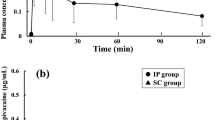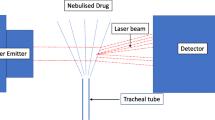Abstract
Objective
To study the pharmacokinetics and local tissue effects resulting from the intratracheal administration of preservative-free fentanyl.
Design
Prospective, randomized, blinded and controlled animal study.
Setting
University research laboratory.
Subjects
Eighteen adult male New Zealand rabbits.
Interventions
Preservative-free fentanyl citrate or normal saline was administered by the intratracheal (i.t.) and intravenous (i.v.) routes to randomized groups of rabbits. The animals were killed at 24, 48 and 72 h following administration.
Measurements and main results
Plasma concentrations of fentanyl were measured before administration and at 2, 5, 10, 30, 60 and 120 min following administration by a specific radioimmunoassay. A detailed histological examination of the lung and tracheal tissue was performed to identify local side effects. There were no significant differences in the plasma fentanyl concentrations resulting from the i.v. or i.t. route of administration. In both groups, the concentrations of fentanyl were within the therapeutic range (i.t. 2.37 ng/ml, i.v. 2.53 ng/ml) by 2 min after injection and reached a maximum concentration within 5 min. The bioavailability of i.t. fentanyl was 71%. Microscopic examination of the respiratory system did not show significant differences between the two random groups overall. However, in the sub-group of animals killed at 24 h, more animals in the i.t. group showed signs of inflammation in the lung parenchyma.
Conclusions
There is rapid absorption of fentanyl following i.t. administration. Pharmacokinetic parameters for fentanyl were not significantly altered by the route of administration. Although there were no signs that i.t. administration of preservative-free fentanyl produces lung injury, a transient and mild inflammatory response was detected at 24 h after administration
Similar content being viewed by others
References
Clotz MA, Nahata MC (1991) Clinical uses of fentanyl, sufentanyl and alfentanyl. Clin Pharm 10: 581–593
Hickey PR, Hansen DD, Wesel et al (1985) Blunting of stress response in the pulmonary circulation of infants by fentanyl. Anesth Analg 64: 1137–1142
Irazuzta J, Pascucci R, Perlman N, Wessel D (1993) Effects of fentanyl administration on respiratory system compliance in infants. Crit Care Med 21: 1001–1004
Anand KJ, Sippell WG, Aynsley-Green A (1987) Randomized trial of fentanyl anaesthesia in preterm babies undergoing surgery: effects on the stress response. Lancet 1: 62–66
Humphrey GB, Boon CM, et al (1992) The occurrence of high levels of acute behavioral distress in children and adolescents undergoing routine venipunctures. Pediatrics 90: 87–91
Anand KJS (1993) Relationships between stress responses and clinical outcome in newborns, infants, and children. Crit Care Med 21: S357-S362
Billmire DA, Neale HW, Gregory RO (1985) Use of intravenous fentanyl in the outpatient treatment of pediatric facial trauma. J Trauma 25: 1079–1080
Katz R, Kelly HW (1993) Pharmacokinetics of continuous infusions of fentanyl in critically ill children. Crit Care Med 21: 995–1000
Gourlay KG, Murphy TM, Plummer JL, et al (1989) Pharmacokinetics of fentanyl in lumbar and cervical CSF following lumbar epidural and intravenous administration. Pain 38: 253–259
Kayser V, Gobeux D, Lombard MC, Guilbaud G, Besson JM (1990) Potent and long lasting antinocioceptive effects after injection of low doses of a muopioid receptor agonist, fentanyl into the brachial plexus sheath of the rat. Pain 42: 215–225
Higgins MJ, Asbury AJ, Brodie MJ (1991) Inhaled nebulized fentanyl for postoperative analgesia. Anaesthesia 46: 973–976
Streisand JB, Varvel JR, Stanski DR (1991) Absorption and bioavailability of oral and transmucosal fentanyl citrate. Anesthesiology 75: 223–229
Varvel JR, Shafer SL, Hwang SS, et al (1989) Absorption characteristics of transdermally administered fentanyl. Anesthesiology 70: 928–934
Tobias JD (1992) Transdermal fentanyl: applications and indications in the pediatric patient. Am J Pain Management 2: 30–33
Mather LE (1983) Clinical pharmacokinetics of fentanyl and its newer derivatives. Clin Pharmacokinet 8: 422–446
Roberts J, Greenberg M, Knaub M, Kendrick Z, Baskin S (1979) Blood levels following intravenous and endotracheal epinephrine administration. JACEP 8: 53–56
Chernow B, Holbrook P, D'Angona D, Zaritsky A, Casey L, Fletcher et al (1984) Epinephrine absorption after intratracheal administration. Anesth Analg 63: 829–832
Hasegawa EA (1986) The endotracheal use of emergency drugs. Pharmacol Crit Care 15: 60–63
Mace SE (1986) Effect of technique of administration on plasma lidocaine levels. Ann Emerg Med 15: 552–556
Jaimovich DG, Osborne JS, Shabino CL (1992) Comparison of intravenous and endotracheal administration of midazolam and the effect on pulmonary functions and histology in the lamb model. Ann Amerg Med 21: 480–489
Barsan WG, Ward JT, Otten EJ (1982) Blood levels of diazepam after endotracheal administration in dogs. Ann Emerg Med 11: 242–247
Hug CC (1984) Pharmacokinetics and dynamics of narcotic analgesics. In: Prys-Roberts C, Hug CC (eds) Pharmacokinetics of anaesthesia. Blackwell Scientific, Oxford, UK, 187–237
Worsley MH, Macleod AD, Brodie MJ, Asbury AJ, Clark C (1990) Inhaled fentanyl as a method of analgesia. Anaesthesia 45: 449–451
Schuyt H, Leene W (1977) An improved method of tracheal intubation in the rabbit. Lab Anim Sci 27: 690–693
Author information
Authors and Affiliations
Rights and permissions
About this article
Cite this article
Irazuzta, J.E., Ahmed, U., Gancayco, A. et al. Intratracheal administration of fentanyl: Pharmacokinetics and local tissue effects. Intensive Care Med 22, 129–133 (1996). https://doi.org/10.1007/BF01720719
Received:
Accepted:
Issue Date:
DOI: https://doi.org/10.1007/BF01720719




